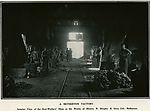 End Welders, N. Hingley & Sons
End Welders, N. Hingley & Sons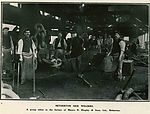 Side Welders, N. Hingley & Sons.
Side Welders, N. Hingley & Sons.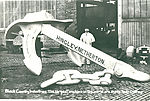 Titanic Anchor
Titanic Anchor Ready To Go
Ready To Go On Its Way
On Its Way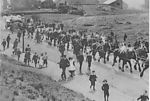 Netherton Celebrates
Netherton Celebrates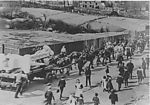 Netherton Celebrates
Netherton Celebrates

The Black Country was not an area renowned for work place harmony but at Hingley’s good working relations existed as a result of the actions on the part of two family members.
Founder of N. Hingley & Sons Ltd, Noah Hingley, began the policy of fair play towards his workforce by introducing his unique contract, “Conditions for Fair Employment”. Standing in the Parliamentary Election of 1874, Noah Hingley used this document as his sole manifesto in order to demonstrate his form of benevolent paternalism.
His son, Benjamin, played a role in the establishment of the “Midland Iron & Steel Wages Board”, and went on to become chairman where he established a reputation amongst employers and employees alike for fairness and impartiality. Based on the “North of England Board of Conciliation”, the Midland Board was founded in 1869, following a six months strike.
The Board’s success was based on two key modes of operation. Firstly every workman was a fee paying member of the Board, which meant that they had a loyalty to the Board, rather than to a Trade Union. Secondly, in addition to the basic rate, wages were settled on a sliding scale based on the selling price of wrought iron bars, a figure independently verified by a public accountant chosen by the employees. Thus industrial peace was assured at Hingley’s factory, and those of the other members of the Board, for more than fifty years.
What made this peace an even more outstanding achievement was the fact that it was a period of considerable unrest, not just in the chainmaking industry, but throughout manufacturing. The work of the M.I.S.W.B. resulted in harmony and stability throughout its membership, whereas the rest of the industry, that which formed up behind the infamous Chain Makers Association, suffered continuous unrest up to and beyond the 1910 lock out.
However, there was one incident, which Sir George Hingley brought about, that lead to some loss of trust between employer and employee. Hingley’s won the order for the cables and anchors for the sister ships Titanic, Brittanic and Olympic. However, Hingley’s decided not to supply hand made wrought iron cables as was their tradition, but to set up a joint venture company with John Brown to make electrically welded cables. This venture, known as the British Machine Made Cable Company, brought a machine from Belgium, and put it to work in Netherton. This must have caused considerable anger amongst the workforce as they would have felt that their loyalty had been betrayed.
The Belgian machine, however, was a failure as it would not handle any cables greater than 2.5ins (64mm). The cables for the three sister ships were to be up to 6ins (152mm) so, perhaps ruefully, the management had to ask the workforce to make the cables. This incident lost Hingley’s some of the goodwill that they had built up over the decades with their employees. When the finished anchor for the Titanic was paraded through the streets of Netherton with the whole village celebrating the event, the works having been given the day off, we can only speculate as to whether this was, in some way, a means by which Sir George Hingley tried to make amends. The White Star Line, owners of the Titanic, were annoyed that Hingley’s had received publicity from the event which indicates that it was not initiated by White Star.
When the Liberal Party returned to power in 1906, a programme of welfare reform was introduced, which began to replace the Hingley style of benevolent paternalism. Sir George Hingley, given the excellent industrial relations enjoyed for the past fifty years, could not see the need for change. His view that there was no need for unemployment insurance, when unemployment was virtually unheard of at Hingley’s, was out of line with events in the country as a whole.
It was due to the efforts of the non-family members that had been brought in to run the business, that Hingley’s made the transition from an extended family providing a protected living for thousands, to a fully commercial enterprise where care for the employees was passed to the state.
In 1913 the firm joined the new Midland Employers Federation, as a result of the new pragmatism brought in by C.E. Lloyd. In 1917 it became the National Employers Federation, which became the Engineering Employers Federation in 1918, one of the confrontational blocs that were to dominate British industrial relations for the next sixty years.
Rollover the captions in the box to see the available images in thumbnail format, click the caption to see the full-size image
| Reference: | 686 |
| Keywords: | |
| Archive Ref: | |
| Updated: | Tue 5 Jun 2007 - 14 |
| Interpretation written by | Louis Howe |
| Author's organisation | Curatorial |
| Organisation's website |